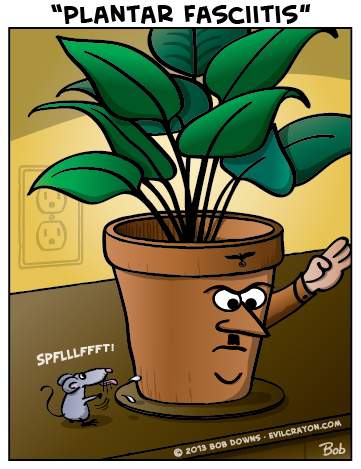جمعه ۳۰ تیر ۹۶ | ۰۴:۰۲ ۶ بازديد

Overview
Plantar fasciitis, or better termed chronic plantar heel pain, is likely caused by a combination of heel Compression, from standing with weight distributed on the heels. Abnormal stress on the foot, from decreased ankle flexibility, pronation, or a high BMI. Footwear, particularly a rigid sole and toe spring, which interferes with foot muscle activity, restricts circulation, and hinders the plantar fascia’s ability to absorb forces. Contrary to popular belief, the condition is not caused by inflammation in the traditional sense, and supportive footwear is possibly more likely to contribute to the problem than help it. Plantar fasciitis doesn’t develop from overuse or too much stress on plantar fascia. It happens when the wrong kind of stress replaces the good kind of stress that the foot needs to remain healthy. The aim of treatment therefore should not be reducing stress on the arch. Instead, treatment should focus on changing the types of stresses being applied and encouraging normal function of the foot.
Causes
There are a number of plantar fasciitis causes. The plantar fascia ligament is like a rubber band and loosens and contracts with movement. It also absorbs significant weight and pressure. Because of this function, plantar fasciitis can easily occur from a number of reasons. Among the most common is an overload of physical activity or exercise. Athletes are particularly prone to plantar fasciitis and commonly suffer from it. Excessive running, jumping, or other activities can easily place repetitive or excessive stress on the tissue and lead to tears and inflammation, resulting in moderate to severe pain. Athletes who change or increase the difficulty of their exercise routines are also prone to overdoing it and causing damage. Another common cause of plantar fasciitis is arthritis. Certain types of arthritis can cause inflammation to develop in tendons, resulting in plantar fasciitis. This cause is particularly common among elderly patients. Diabetes is also a factor that can contribute to further heel pain and damage, particularly among the elderly. Among the most popular factors that contribute to plantar fasciitis is wearing incorrect shoes. In many cases, shoes either do not fit properly, or provide inadequate support or cushioning. While walking or exercising in improper shoes, weight distribution becomes impaired, and significantly stress can be added to the plantar fascia ligament.
Symptoms
Most people with plantar fasciitis have pain when they take their first steps after they get out of bed or sit for a long time. You may have less stiffness and pain after you take a few steps. But your foot may hurt more as the day goes on. It may hurt the most when you climb stairs or after you stand for a long time. If you have foot pain at night, you may have a different problem, such as arthritis, or a nerve problem such as tarsal tunnel syndrome.
Diagnosis
To arrive at a diagnosis, the foot and ankle surgeon will obtain your medical history and examine your foot. Throughout this process the surgeon rules out all the possible causes for your heel pain other than plantar fasciitis. In addition, diagnostic imaging studies such as x-rays or other imaging modalities may be used to distinguish the different types of heel pain. Sometimes heel spurs are found in patients with plantar fasciitis, but these are rarely a source of pain. When they are present, the condition may be diagnosed as plantar fasciitis/heel spur syndrome.
Non Surgical Treatment
Although there is no single cure, many treatments can be used to ease pain. In order to treat it effectively for the long-term, the cause of the condition must be corrected as well as treating the symptoms. Rest until it is not painful. It can be very difficult to rest the foot as most people will be on their feet during the day for work. A plantar fasciitis taping technique can help support the foot pain map (rosaleeengels.soup.io) relieving pain and helping it rest. Plantar fasciitis tapingApply ice or cold therapy to help reduce pain and inflammation. Cold therapy can be applied for 10 minutes every hour if the injury is particularly painful for the first 24 to 48 hours. This can be reduced to 3 times a day as symptoms ease. Plantar fasciitis exercises can be done if pain allows, in particular stretching the fascia is an important part of treatment and prevention. Simply reducing pain and inflammation alone is unlikely to result in long term recovery. The fascia tightens up making the origin at the heel more susceptible to stress. Plantar fasciitis night splint. Plantar fasciitis night splint is an excellent product which is worn overnight and gently stretches the calf muscles preventing it from tightening up overnight.

Surgical Treatment
Most studies indicate that 95% of those afflicted with plantar fasciitis are able to relieve their heel pain with nonsurgical treatments. If you are one of the few people whose symptoms don't improve with other treatments, your doctor may recommend plantar fascia release surgery. Plantar fascia release involves cutting part of the plantar fascia ligament in order to release the tension and relieve the inflammation of the ligament. Overall, the success rate of surgical release is 70 to 90 percent in patients with plantar fasciitis. While the success rate is very high following surgery, one should be aware that there is often a prolonged postoperative period of discomfort similar to the discomfort experienced prior to surgery. This pain usually will abate within 2-3 months. One should always be sure to understand all the risks associated with any surgery they are considering.
Prevention
Being overweight can place excess pressure and strain on your feet, particularly on your heels. Losing weight, and maintaining a healthy weight by combining regular exercise with a healthy, balanced diet, can be beneficial for your feet. Wearing appropriate footwear is also important. Ideally, you should wear shoes with a low to moderate heel that supports and cushions your arches and heels. Avoid wearing shoes with no heels.